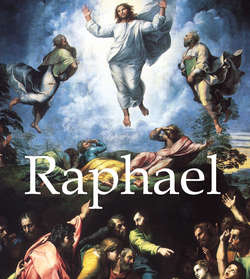Читать книгу Raphael - Eugène Müntz - Страница 3
На сайте Литреса книга снята с продажи.
Birth of Raphael and his First Works
ОглавлениеOn the 6th of April 1483, Raphael, who would carry to such heights of glory the name of Santi, was born in Urbino, Italy. His father, Giovanni Santi, gave him the name of an archangel, as though guessing the celestial splendour to which his son would rise. Giovanni was a modest and thrifty member of the middle class, ready to accept any commission, provided it was well remunerated.
Angel Holding a Phylactery (fragment of the Baronci Altarpiece)
1500–1501
Oil on wood, 58 × 36 cm
Musée du Louvre, Paris
To judge him only by his ordinary occupations, one would be tempted to take him for an artisan rather than an artist, so diverse and varied were his activities. But this worker, so humble in appearance, had travelled extensively. He had studied the works of the most famous masters; he possessed the secrets of the trade and stopped at nothing in order to remain abreast of new methods. He had observed and read widely, and the names of the humanists were familiar to him.
The Crucified Christ with the Virgin Mary, Saints and Angels (The Mond Crucifixion)
c. 1502–1503
Oil on poplar wood, 283.3 × 167.3 cm
The National Gallery, London
Given Giovanni Santi’s tastes, we may assume that, in addition to a very careful artistic education, his son received a good and solid literary one as well. Raphael lost his mother at the age of eight, and his father four years later. In spite of Giovanni Santi’s premature death, knowledgeable judges see several similarities of style between the works of the father and those of his son. It is quite probable that Raphael received some lessons from his father. How was the interval separating the death of Giovanni Santi and Raphael’s departure for Perugia filled?
The Madonna and Child with a Book
c. 1502–1503
Oil on wood, 55.2 × 40 cm
Norton Simon Museum of Art, Pasadena, California
It is probable that in his native city the boy received lessons from his compatriot Timoteo Viti. This capable painter, whose value should, nonetheless, not be exaggerated, had returned to Urbino in 1495 after solid studies done in Bologna in the workshop of Francia. A tender friendship immediately united the two artists. In his period of grandeur, Raphael did not forget the companion of his youth; he called him to him in Rome, and asked for his help in the execution of the Sibyls and the Prophets in the church of the Pace.
Head of a Boy with a Cap
c. 1502–1503
Black chalk, 21.2 × 18.6 cm
Palais des Beaux-Arts, Lille
